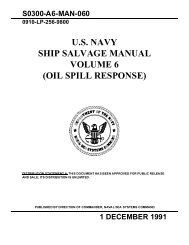U.S. NAVY SALVAGE REPORT DEEPWATER HORIZON ... - ESSM
U.S. NAVY SALVAGE REPORT DEEPWATER HORIZON ... - ESSM
U.S. NAVY SALVAGE REPORT DEEPWATER HORIZON ... - ESSM
You also want an ePaper? Increase the reach of your titles
YUMPU automatically turns print PDFs into web optimized ePapers that Google loves.
Final Report, SONS Deepwater Horizon Oil Spill, Gulf of Mexico, 27 April — 24 September 2010<br />
ready for tasking by the USCG. All the teams conducted training and drills. The spud barge,<br />
with two Class V Vessel Skimmers on board in Gulfport, was re-positioned near Cat Island.<br />
Two Class V Skimmer Systems were on a barge at Rigolets in Slidell for better positioning to<br />
protect the entrances to Lake Ponchartrain.<br />
Oil Containment Boom and Boom Mooring Systems removal operations were in progress at<br />
Mobile Bay.<br />
The OSV Wes Bordelon (in Venice) deployed 3000′ of USS-26″ Oil Containment Boom and<br />
Boom Mooring Systems at the North Pass.<br />
The Grand Isle SUPSALV onshore crew deployed another 1000′ of USS-26″ Oil Containment<br />
Boom near-shore at the bridge to Grand Isle.<br />
The OSV AHTS Vanguard, equipped two Current Buster VOSS onsite at MC252, recovered<br />
1908 barrels of product total cumulative to date. There was a reduction in recovered product<br />
after decanting or stripping 337 barrels of water, which reflected a first-rate estimated recovery<br />
efficiency of 83 percent.<br />
ICP Houma requested the loading of two High Speed Current Buster VOSS and one Class XI<br />
Skimmer onto three separate vessels of opportunity (VOO). SUPSALV advised ICP Houma that<br />
the two High Speed Current Buster VOSS would be more effective on a single larger VOO with<br />
internal tanks, same configuration used on board the OSV AHTS Vanguard. This configuration<br />
primarily eliminated the requirement to pump recovered oil into a Spill Recovery Bladder, and<br />
then manage offloading to larger capacity barges (double handling). ICP Houma operations<br />
understood this, but priorities were driving multiple smaller vessels skimming with SUPSALV<br />
equipment. Eventually ICP Houma agreed, and two High Speed Skimmers were loaded on the<br />
OSV MV John Coghill and a different OSV would be provided for the Class XI System.<br />
Sunday, 23 May 2010<br />
Having continued coordinating authority over the majority of SUPSALV OSR equipment, the<br />
Federal Reserve Asset Staging Unit in Gulfport (State Pier West) anticipated additional<br />
positioning per the USCG FOSC direction. Indications were that most, if not all, Class V<br />
Skimmer Systems awaiting assignment in Gulfport would be directed to Louisiana.<br />
Twelve Class V Vessel Skimmers with full crews were still pre-positioned as follows: Rigolets<br />
(qty 4), Cat Island (qty 2), Pascagoula (qty 2), Bayou La Batre (qty 1), and Pensacola (qty 1), all<br />
ready for tasking by the USCG. The teams conducted training and drills.<br />
SUPSALV Oil Containment Boom and Boom Mooring removal operations were in progress at<br />
Mobile Bay.<br />
The OSV Wes Bordelon left Venice and deployed 2000′ of USS-26″ Oil Containment Boom<br />
with Boom Mooring Systems at the North Pass for a total of 5000′ of Oil Containment Boom in<br />
that location.<br />
24

















